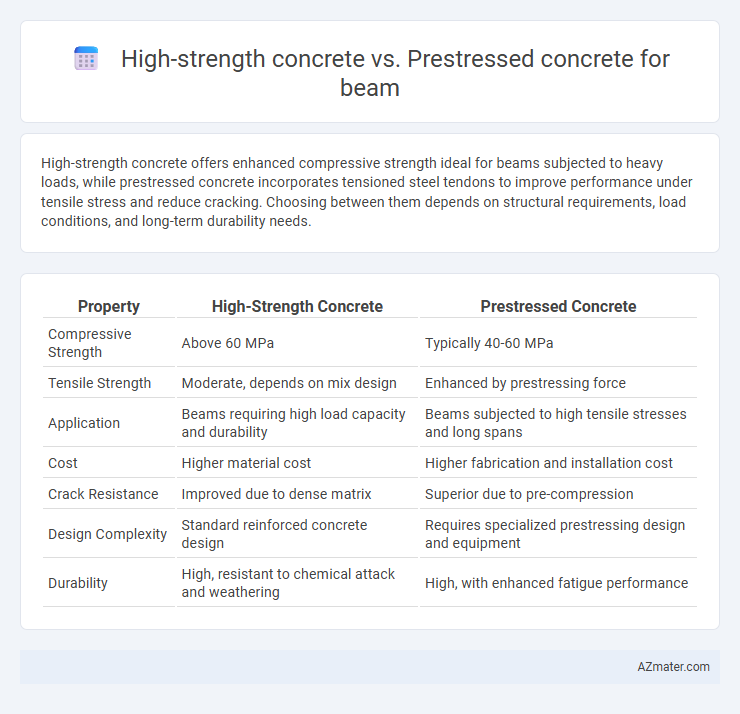High-strength concrete offers enhanced compressive strength ideal for beams subjected to heavy loads, while prestressed concrete incorporates tensioned steel tendons to improve performance under tensile stress and reduce cracking. Choosing between them depends on structural requirements, load conditions, and long-term durability needs.
Table of Comparison
| Property | High-Strength Concrete | Prestressed Concrete |
|---|---|---|
| Compressive Strength | Above 60 MPa | Typically 40-60 MPa |
| Tensile Strength | Moderate, depends on mix design | Enhanced by prestressing force |
| Application | Beams requiring high load capacity and durability | Beams subjected to high tensile stresses and long spans |
| Cost | Higher material cost | Higher fabrication and installation cost |
| Crack Resistance | Improved due to dense matrix | Superior due to pre-compression |
| Design Complexity | Standard reinforced concrete design | Requires specialized prestressing design and equipment |
| Durability | High, resistant to chemical attack and weathering | High, with enhanced fatigue performance |
Introduction to Beam Construction Materials
High-strength concrete exhibits compressive strengths typically above 6,000 psi, providing enhanced durability and load-bearing capacity essential for beam construction. Prestressed concrete incorporates tensioned steel tendons, enabling beams to withstand higher tensile stresses and reduce cracking under service loads. Both materials optimize structural performance, with high-strength concrete improving compressive resistance and prestressed concrete enhancing flexural capacity in beam applications.
Overview of High-Strength Concrete
High-strength concrete (HSC) is characterized by compressive strengths typically exceeding 6,000 psi (41 MPa), offering enhanced durability and load-bearing capacity compared to normal concrete. In beam applications, HSC provides superior performance under high stresses with reduced cross-sectional area, promoting slender and efficient designs. Its dense microstructure improves resistance to cracking and environmental degradation, making it ideal for structures requiring longevity and resilience.
Understanding Prestressed Concrete
Prestressed concrete beams incorporate high-strength steel tendons that are tensioned before or after concrete casting to enhance load-bearing capacity and control tensile stresses, offering superior performance compared to conventional high-strength concrete beams. This pre-tensioning or post-tensioning process minimizes cracks and deflections, allowing for longer spans and reduced material usage in beam construction. Understanding the principles of prestressing is crucial for optimizing structural efficiency, durability, and serviceability in concrete beam design.
Material Properties Comparison
High-strength concrete exhibits compressive strengths above 6,000 psi, offering enhanced durability and resistance to environmental factors, while prestressed concrete incorporates high-tensile steel tendons to counteract tensile stresses and improve load-bearing capacity. The enhanced bond between high-strength concrete and prestressing strands allows prestressed beams to achieve superior flexural performance and reduced crack widths compared to conventional high-strength concrete beams. Material properties such as modulus of elasticity, tensile strength of reinforcing steel, and creep behavior play critical roles in optimizing the design and performance of both beam types under service loads.
Strength and Load-Bearing Capacity
High-strength concrete offers compressive strength typically above 6000 psi, enhancing the beam's durability and resistance to mechanical stresses. Prestressed concrete incorporates internal stresses via tensioned steel tendons before loading, significantly increasing the beam's load-bearing capacity and controlling crack propagation under service loads. Combining both materials results in beams capable of supporting greater spans and higher loads with improved structural efficiency in bridges and high-rise constructions.
Durability and Service Life
High-strength concrete beams exhibit enhanced durability through increased compressive strength, reduced permeability, and improved resistance to environmental factors such as freeze-thaw cycles and chemical attacks, extending their service life significantly. Prestressed concrete beams benefit from induced compressive stresses that counteract tensile stresses, minimizing crack formation and improving load-carrying capacity, which enhances durability under dynamic and cyclic loading conditions. Both materials contribute to prolonged service life, but prestressed concrete beams typically demonstrate superior performance in long-span structures due to their ability to control crack widths and reduce maintenance requirements.
Construction Techniques and Methodologies
High-strength concrete beams are cast using conventional formwork and curing methods, emphasizing controlled mixing and extended curing times to achieve enhanced compressive strength. Prestressed concrete beams require specialized tensioning equipment where tendons are tensioned before or after casting, enabling the concrete to resist tensile stresses under service loads. Construction methodologies for prestressed beams involve precise anchoring and stressing sequences, often demanding prefabrication for quality control and accelerated site assembly.
Cost Considerations and Efficiency
High-strength concrete reduces beam size and material volume, lowering raw material costs but may increase expenses due to specialized mixing and curing processes. Prestressed concrete beams offer improved load capacity and span length with less material, enhancing overall construction efficiency and reducing labor costs in the long term. Cost efficiency depends on project scale and design requirements, as prestressed concrete typically demands higher upfront investment yet delivers greater structural performance and reduced maintenance expenses.
Common Applications in Beam Design
High-strength concrete is commonly used in beams requiring enhanced load-bearing capacity and durability, such as in high-rise buildings and long-span bridges, where its compressive strength exceeds 6,000 psi. Prestressed concrete beams are preferred in applications involving long spans and heavy loads like parking structures, highway overpasses, and industrial buildings due to their ability to counteract tensile stresses and reduce cracking. Both materials optimize beam performance, but high-strength concrete suits compressive stress scenarios while prestressed concrete excels in tension-controlled environments.
Conclusion: Selecting the Optimal Concrete Type
High-strength concrete offers excellent compressive strength suitable for beams requiring durability and load-bearing capacity without additional reinforcement, making it ideal for simpler, cost-effective designs. Prestressed concrete incorporates tensioned steel tendons to counteract tensile stresses, enhancing beam performance under dynamic loads and allowing longer spans with reduced beam depth. Selecting the optimal concrete type depends on design requirements, load conditions, and structural complexity--prestressed concrete is preferable for longer spans and high load variations, while high-strength concrete is suitable for standard beam applications with high compressive demands.

Infographic: High-strength concrete vs Prestressed concrete for Beam
 azmater.com
azmater.com